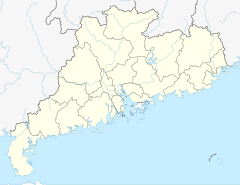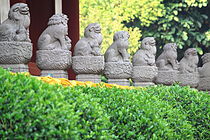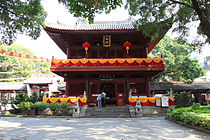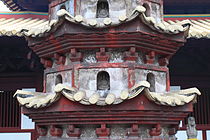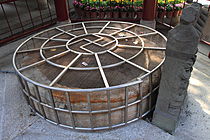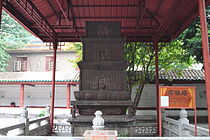Guangxiao Temple (Guangzhou)
This article needs additional citations for verification. (October 2014) |
| Guangxiao Temple | |
|---|---|
光孝寺 | |
 | |
| Religion | |
| Affiliation | Buddhism |
| Deity | precepts school, Chan (Zen), Shingon Buddhism, and Pure Land |
| Location | |
| Location | Yuexiu District, Guangzhou, Guangdong |
| Country | China |
| Geographic coordinates | 23°07′56″N 113°15′04″E / 23.1321°N 113.251°E |
| Architecture | |
| Style | Chinese architecture |
| Founder | Yu Fan's family |
| Date established | 233 |
| Guangxiao Temple | |||||||||||||
|---|---|---|---|---|---|---|---|---|---|---|---|---|---|
| Chinese | 光孝寺 | ||||||||||||
| Literal meaning | Bright Obedience Temple Bright Filial-Piety Temple | ||||||||||||
| |||||||||||||
| Former names | |||
|---|---|---|---|
| Zhizhi Temple | |||
| Traditional Chinese | 制旨寺 | ||
| Simplified Chinese | 制止寺 | ||
| |||
| Wangyuanchaoyan Temple | |||
| Chinese | 王苑朝延寺 | ||
| |||
| Wangyuan Temple | |||
| Traditional Chinese | 王園寺 | ||
| |||
| Qianmingfaxing Temple | |||
| Traditional Chinese | 乾明法性寺 | ||
| |||
| Chongningwanshou Temple | |||
|---|---|---|---|
| Traditional Chinese | 崇寧萬壽寺 | ||
| |||
| Baoenguangxiaochan Temple | |||
| Traditional Chinese | 報恩廣孝禪寺 | ||
| |||
Guangxiao Temple (Chinese: 光孝寺) is one of the oldest Buddhist temples in Guangzhou, the capital of China's Guangdong Province.[1] As the special geographical position, Guangxiao Temple often acted as a stopover point for Asian missionary monks in the past. It also played a central role in propagating various elements of Buddhism, including precepts school, Chan (Zen), Shingon Buddhism, and Pure Land. In this temple, Huineng, the sixth Chinese patriarch of Chan Buddhism, made his first public Chan lecture and was tonsured, and Amoghavajra, a Shingon Buddhist master, gave his first teaching of esoteric Buddhism.[2] Many Buddhist scriptures were also translated here, including those translated by Yijing and the Shurangama-sūtra translated by Paramitiin (般剌密諦).[2]
History
[edit]Han dynasty
[edit]Guangxiao originated from the residence of Zhao Jiande, the king of Nanyue whose usurpation prompted Emperor Wu of the Han (206 BC–8 AD) to invade and annex the area. During the Three Kingdoms, the Wu officer and scholar Yu Fan was banished to live at the residence. After Yu Fan died in 233, his family donated the estate, whose grounds were organized as the Zhizhi Temple.[3] It was repeatedly renamed: the Wangyuanchaoyan Temple, the Wangyuan Temple, the Qianmingfaxing Temple, the Chongningwanshou Temple, and the Baoenguangxiaochan Temple.
Between the 4th and 10th centuries, many monks from South Asia (especially India) or mainland China came to the coastal Guangxiao Temple. During the period, Guangxiao Temple reached its peak. In the subsequent centuries, some eminent Chinese monks also visited or lived at Guangxiao Temple to propagate Buddhism, such as Danxia Tianran (丹霞天然) and Yangshan Huiji.
Ming dynasty
[edit]In 1482, the Chenghua Emperor of the Ming dynasty renamed it Guangxiao Temple and personally recorded the new name on a stele. Since then, the temple has kept the name "Guangxiao".
Qing dynasty
[edit]In the 17th century, Guangxiao Temple fell into decline, although it underwent minor restoration several times.
Modern China
[edit]In the last two centuries, Guangxiao Temple was fatally damaged by the movement to "Requisition Temple Property to Promote Education" (廟產興學; 1898–1931) and the Cultural Revolution (1966–1976). Over this period, most of the buildings of Guangxiao Temple were either destroyed or occupied for secular usage.
In the 1980s, Guangxiao Temple was reoccupied by Buddhist monks. Since then, some of its main halls have been rebuilt, such as the Mahavira Hall, Samghrma Hall, and Ksitigarbha Hall. ‘Dharma pillars’ have also been erected in front of each hall. In addition, an animal liberation pond has been built near these structures. These reconstructed buildings have restored Guangxiao Temple to some extent, however the scale of the temple today is much smaller than in the past.[citation needed]
The temple's records are principally recorded in a thread-bound edition entitled The Annals of Guangxiao Temple (光孝寺志), written in 1769.[2]
Architecture
[edit]The extant buildings and halls include the Shanmen, Four Heavenly Kings Hall, Mahavira Hall, Hair Burying Pagoda, etc.[3][4]
Mahavira Hall
[edit]The Mahavira Hall was originally built in 401 in the Eastern Jin dynasty (317–420) by senior monk Dharmayasas from Western Regions. Rebuilt and renovated in many dynasties, now it is 35.36-metre (116.0 ft) wide, 24.8-metre (81 ft) deep and 13.6-metre (45 ft) high and preserves the largest, grandest and most magnificent hall in Lingnan Region. Flat and far-reaching, the eaves of the hall can adapt to the high temperature and heavy rains in the south China and the beams and pillars can avoid erosion by wind and rain. Instead of brick walls, the hall is surrounded by wooden windows which are engraved with flower patterns. Some of the windows are decorated with translucent shells, which dissipate heat, ventilate and collect light well. The hall houses statues of Sakyamuni, Amitabha and Maitreya.[5][6]
Great Compassion Column
[edit]The Great Compassion Column (大悲幢) stands in front of the Mahavira Hall. It was made in 826 during the reign of Emperor Jingzong of the Tang dynasty (618–907). It is over 2-metre (6 ft 7 in) high and made of green marble. Octagonal in shape, it has elegant style with a mushroom-shaped canopy on the top and engraved relief of Hercules at the bottom base. The Great Compassion Mantra in Sanskrit and Chinese are inscribed on the body.[7]
Hair Burying Pagoda
[edit]Under the Bodhi tree behind the Mahavira Hall, there is the Hair Burying Pagoda (瘗髪塔). In 676 during the Yifeng era (676–679) in the Tang dynasty (618–907), master Huineng cut his hair and received ordination as a monk. Abbot Yinzong (印宗) buried his hair here and built a pagoda to commemorate it. Octagonal in shape and 7.8-metre (26 ft) high, it has 7 stories with 8 niches on each.[5][8]
East Tower and West Tower
[edit]Two iron pagoda are erected behind the Mahavira Hall, which are the oldest existing iron towers in China. Built in the 963 in the Southern Han dynasty (907–960), the original West Tower was seven stories but now only preserves the bottom three floors.[9]
The East Tower was built in the 967 in the Southern Han dynasty (907–960) by Emperor Liu Chang. Square in shape, it has seven stories with the height of 7.69-metre (25.2 ft). Over 900 exquisite niches with small statues of Buddha are carved on the body of the pagoda. When first built, it was covered with gold and known as Gilded Thousand Buddha Pagoda (涂金千佛塔).[9]
Transportation
[edit]The temple is accessible within walking distance north of Ximenkou Station of Guangzhou Metro.
Gallery
[edit]See also
[edit]- Chinese Buddhism
- List of Buddhist temples
- Six Banyan Temple
- Hualin Temple (Guangzhou)
- Hoi Tong Monastery
- Benhuan
References
[edit]- ^ "Brief information on Guangxiao Temple". ChinaTourOnline.com. Retrieved 3 October 2014.
- ^ a b c Li, Xican (2016). "Guangxiao Temple (Guangzhou) and its Multi Roles in the Development of Asia-Pacific Buddhism". Asian Culture and History. 8 (1): 45–56. doi:10.5539/ach.v8n1p45. Retrieved 16 August 2017.
- ^ a b Zhang Yuhuan (2012), p. 200.
- ^ Zi Yan (2012), p. 105.
- ^ a b Zhang Yuhuan (2012), p. 201.
- ^ Zi Yan (2012), p. 105–106.
- ^ Zi Yan (2012), p. 106.
- ^ Zi Yan (2012), p. 106–107.
- ^ a b Zi Yan (2012), p. 107–108.
Bibliography
[edit]- Zi Yan (2012). Famous Temples in China (in English and Chinese). Hefei, Anhui: Huangshan Publishing House. ISBN 978-7-5461-3146-7.
- Zhang Yuhuan (2012). "The Oldest Buddhist Temple in Lingnan Region: Guangzhou Guangxiao Temple" 《岭南最古老的寺院:广州光孝寺》. 《图解中国著名佛教寺院》 [Illustration of Famous Buddhist Temples in China] (in Chinese). Beijing: Contemporary China Publishing House. ISBN 978-7-5154-0135-5.

